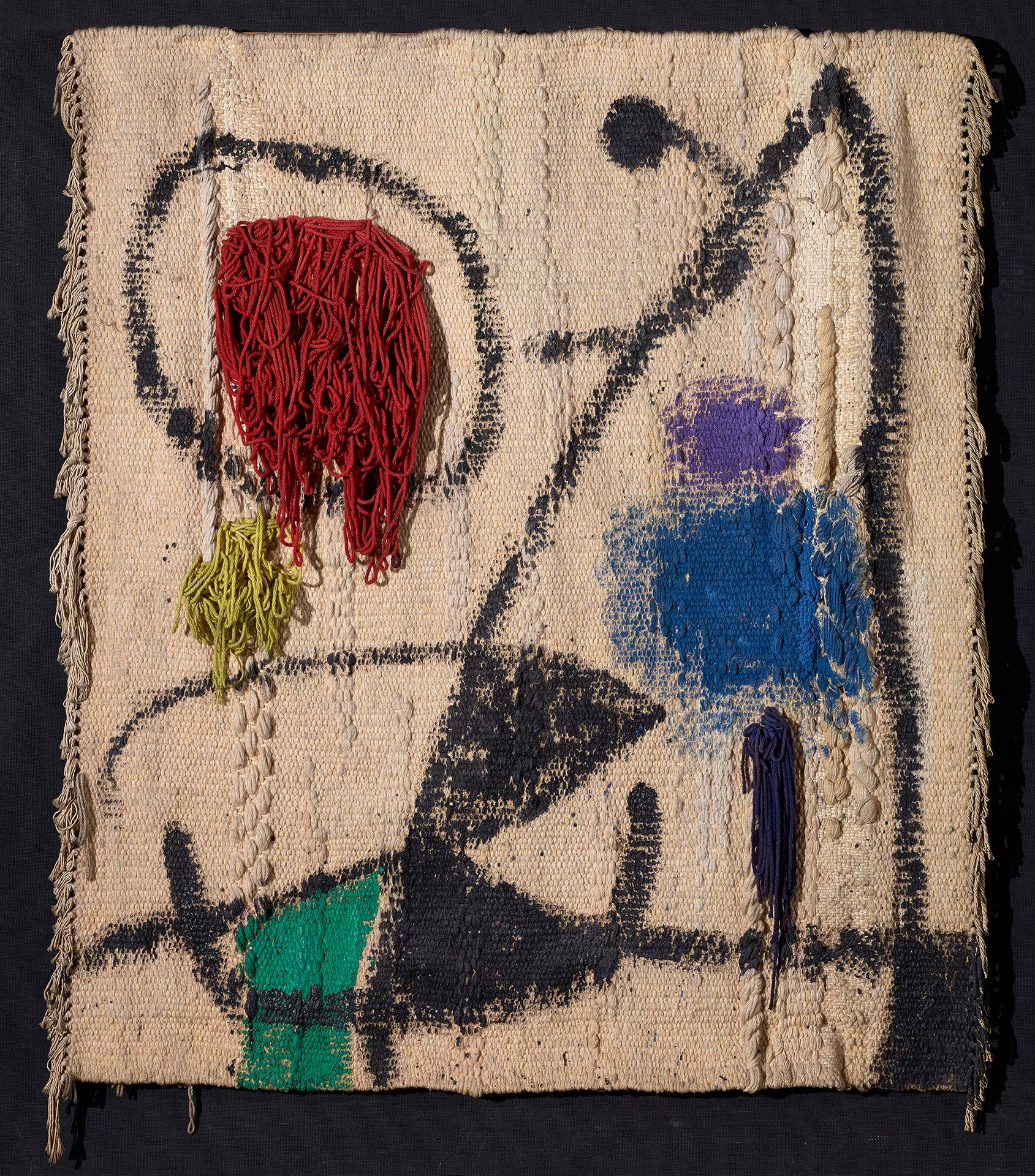
Joan Miró (Barcelona, 1893 – Palma de Mallorca, 1983)
Sobreteixim
1972
WORK INFORMATION
Tapestry and paint on hessian, 165 × 150 cm
OTHER INFORMATION
Signed and dated on a label sewn onto the reverse: "I a V 1972 Joan Miró"
In the course of a creative lifetime, every artist goes through different phases. Though this is not the place for a review of the entire life of a genius, it is interesting to examine Joan Miró's frame of mind at the time he created Sobreteixim and the oil on canvas Personnage [Personage]. At the ripe old age of 80, Miró was busy devising a mature response to the changes and sweeping reforms that Spain faced. Moreover, at that time he was preparing the major retrospective of his work at the Grand Palais in Paris, which opened in 1974. As Isabelle Monod-Fontaine noted, "He did not want to be considered a painter because he already had all of his work behind him, and the truth is that in 1973 [...] he was more active than ever [...]. When we visited his studios, it wasn't just a dialogue with Miró; rather, in the end we were a group of people who moved in his universe."
We cannot overlook the transcendental quest for the support or the collaboration of the artist Josep Royo on certain projects, who wove and knotted all of the sobreteixims—a Catalan word that literally means "over-weave" and refers to a small piece of fabric used to patch another, larger piece—by hand. From the very first, Miró was deeply impressed by the contemporary freshness that Royo's extraordinary craftsmanship brought to this rich, unique, age-old textile culture. It is surprising to observe how the plaiting and knotting of fine materials like wool, cotton and jute add a three-dimensional quality to the work. After seeing Jackson Pollock's show in Paris in 1952, Miró's hand was liberated and a visceral, gestural creative frenzy violently exploded in his works, with no fear of what others might think or say. After his second trip to Japan in 1970, he remarked, "I was fascinated by the work of Japanese calligraphers and it definitely influenced my own working methods. I work more and more in a state of trance, I would say almost always in a trance these days. And I consider my painting more and more gestural." The importance of black was increasingly visible, and it became clear that Miró was in the grip of a creative obsession that absorbed him entirely, body and soul. What he created is closer to an "assemblage-tapestry", adding accents of colour with bits of red, yellow and blue yarn sewn directly onto the surface. Miró painstakingly "constructed" his Sobreteixim (1972) by hand, generating tension between the colours of the yarn and the colours applied with a brush. The end result is a work consisting of splashes of colour on an almost rocky surface, similar to the rock art at Altamira.
Personage was finished in 1973 and eventually exhibited at the Miró retrospective held in 1974 at the Grand Palais in Paris. In an interview with French critic Yvon Taillandier that same year, Miró stated, "I never repeat myself. One figure always leads me another figure [...] For me, the essential things are the artistic and poetic occurrences, the associations of forms and ideas: a form gives me an idea, this idea evokes another form, and everything culminates in figures, animals, and things I had no way of foreseeing in advance." The free association of ideas influences the outcome of the work and, as Freud noted, "As sources of dream-images, subjective sensory excitations have the obvious advantage of not being dependent, like objective ones, upon external chance." Miró was a fisher of dream-images submerged in his inner ocean and, as Breton said, only he had direct access to them. Personage ratifies the "construction" of his being through the thickness of the paint layers and the juicy brushstrokes that materialise them. The spectator stoically faces the simplification of an ethereal, fleeting instant, captured and taken alive from the night hours. [Joan Punset Miró]

